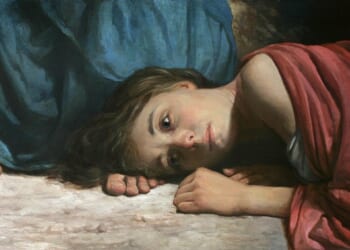When he was asked how Paul Cézanne influenced his work, Picasso declared: “He is the father of us all, a sort of God of painting.” This admiration was shared by Picasso’s coeval Cubist-in-arms, Georges Braque, and by the founding father of Fauvism, Henri Matisse, as well as by many other artists who came to prominence after Cézanne’s death in 1906. Cézanne’s contemporaries likewise appreciated his massive talent. Long before he received public attention, various Impressionists and Post-Impressionists, such as Monet, Renoir, Pissarro, Gauguin, and Van Gogh, understood Cézanne’s mission: to produce profound, lasting works that were entirely original and undeniably true. Indeed, it is almost impossible to quantify Cézanne’s influence on modern art. To this very day, abstract and figurative painters alike can trace their aesthetic genealogies, including their methods, styles, and sensibilities, back to the innovations achieved by that cantankerous genius from Aix-en-Provence.
What is more often overlooked, is Cézanne’s enormous impact on modernist poetry, in particular his sway over three distinct, highly influential poets: Rainer Maria Rilke, Wallace Stevens, and William Carlos Williams, each of whom he affected in entirely different ways. Biographies of these three poets all acknowledge the debts they owe the painter for their respective innovations, but little effort has been made to summarize the full effect this singular artist had on the course of modernist poetry.
“On my death,” wrote Wallace Stevens in a letter to a friend, “there will be found carved on my heart the name of Aix-en-Provence.” Though Stevens was fascinated by France, he never visited and knew its vibrant and verdant landscape only through depictions by his unmet mentor. Stevens was addicted to the visual arts and spent many Saturday afternoons at home perusing catalogues of modern European artworks, examining image after image for exportable conceits he could deploy in his own compositions. He also loved the curious dreamscapes of Paul Klee, and he often confided in friends and family members that he wanted to produce poems as original and vivid as the paintings of Cézanne and Klee. Cézanne’s reduction of the world to a “few monumental objects,” as Helen Vendler put it, impressed Stevens enormously. Stevens’s study of art was a process that inspired many of his oft-quoted poems from the 1940s onwards. In Cézanne’s sublime still lifes, piercing portraits, and inimitable landscapes, apples become planetary, mountains become at once massive and miniscule, and the faces of ordinary people become complex ciphers and mesmerizing masks. By homing in on the primary qualities of these subjects, Cézanne discovered an unsung harmony across the physical world. This underlying commonality, unearthed and emphasized by Cézanne, was an idea that resonated profoundly with Stevens. In many of his later verses, he praised an author or artist’s ability to express the immensities latent in basic objects and common situations. If Cézanne had uttered his famous pronouncement that “with an apple, I will astonish Paris” in Stevens’s presence, he would have undoubtedly received an enthusiastic “hear, hear!” from the poet.
While Stevens’s style often was characterized by coherence of thought and ostensive simplicity, his contemporary William Carlos Williams took those qualities to an extreme. Williams’s unadorned and seemingly crystal-clear poems disclose depths and dimensions a desultory read will invariably fail to reveal. Williams was animated by Cézanne’s ruthless pursuit of simplicity, of stripping back the unnecessary to expose the core of an object. He argued that the process of making a good painting and composing a good poem were one and the same, and that poetry should impress a reader in the way that a painting impresses a viewer. Process, to Williams, was as important as the subjects selected. For Williams, Cézanne’s later works were a running commentary on methods of observation and expression as much as they were about their subjects. In 1964, he communicated his admiration for the painter to his readers in a poem called “Cézanne,” in which he wrote, “art is all we// can say to reverse/ the chain of events and make a pileup/ of passion to match the stars.” Williams was one of the last poets of a generation for whom the arts assumed the proportions of a formal religion. For Williams, the papal throne of that edifying faith could well have been reserved for Cézanne.
Of the three poets, however, Rilke was the most indebted to and dramatically inspired by the artist. His first viewing of a Cézanne painting, at a memorial exhibition in Paris in 1907, struck him like a flaming arrow. Thereafter, he spent several months penning enthusiastic letters to his wife about the revelatory value of Cézanne’s many masterpieces.
When asked who his supreme influence was, he answered resolutely and memorably, “After the master’s death, I followed his traces everywhere.” The “conflagration of clarity” Cézanne occasioned in Rilke did much more than indent his verse style or method of composition—it converted the nomadic mystical poet into a true zealot of the arts, into a man who, like Cézanne, was willing to sacrifice the comforts of a conventional life to pursue the creation of something that would last forever. Cézanne was more than just a painter to Rilke. He was a patron saint for artistic outsiders. Indeed, he repeatedly compared Cézanne to saints and prophets, saying of the painter’s obsession with his neighborhood mountain, Mont Sainte-Victoire, “not since Moses has anyone seen a mountain so greatly.”
Cézanne was famous for his indifference to bourgeois life, for his extreme self-centeredness, and for his sequestering himself away from society so that he could devote his entire existence to art. He famously missed his own mother’s funeral to keep up progress on a promising picture. Such an ordering of priorities certainly made sense to Rilke, who noted the importance of that anecdote to his wife.
Writerly appreciation for Cézanne was not reserved for poets. Most literary modernists, including many prominent novelists, admired the Moses of Provence profoundly. Gertrude Stein confessed that “everything I have done has been influenced by Flaubert and Cézanne.” To my knowledge, no painter has ever had such a dramatic effect on the course, character, and execution of literature in the whole history of Western art.
In an after-dinner lecture, T. S. Eliot spoke of the relationship between sister media, saying, “It is the function of all art to give us some perception of an order in life, by imposing an order upon it. The painter works by selection, combination, and emphasis among the elements of the visual world, the musician in the world of sound.” The order Cézanne imposed on the world revealed a rich array of boundless possibilities for these three poets. He was a role model to them in terms of his talent as well as his temperament. The influence of his innovative work on modern poetry is a legacy that ought to be more widely recognized.
I had a tutor at university who argued that all great poets secretly want to be composers or philosophers or, indeed, both. According to him, music affords an artist the means to express himself more broadly and deeply than language allows, and the restraints of philosophy force a mind to distill its thoughts, producing the purest possible ideas. Cézanne’s immense influence on three of the most influential poets of the previous century suggests that some great poets would also be content to speak in paint.














